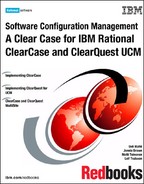Clients
In ClearCase the terms client and server are a bit mixed when it comes to host functionality. Most ClearCase clients act as servers when they provide storage for views, and processor time and memory for the view server processes. On the other hand you can, in most cases, use any ClearCase server to access and even to modify the data in VOBs and views using normal ClearCase interfaces:
If a ClearCase client can provide local views, it could provide local VOBs, too, and any other ClearCase client in the registry could access them.
The servers can act as clients; for example, a VOB server is a client to the registry server.
Most often the server hosts for VOB, license, and registry services are dedicated to provide only the services. The users use ClearCase clients (hosts where ClearCase is installed) and run ClearCase processes and possibly view server processes.
So, for this book, let us use server to refer to a host dedicated to act as a service provider for VOB, license, registry, or view server services. The client, then, will be a host used by one or several users to access data in ClearCase VOBs. The client host can be running view server processes for local views.
When you have the server roles operational, it is time to test the first client setup from the release area. Start with a freshly installed operating system with correct patches or service packs, add additional communications software (for example, NFS) and use the site default settings you defined for ClearCase. Verify after installation that the client is in the correct ClearCase region and uses the correct license server.
If the client install does not go as planned, go to the release area and run site preparation again to create new site settings for the clients, and install the client again using the new settings.
Try the basic functions from the client. Create a local dynamic view with default settings, create a test VOB to the server, and create different element types and some versions of them just to verify that the basic functionality works. When using Windows clients and a UNIX server, the VOB has to be created in UNIX, and you may use the ClearCase Region Synchronizer to get the VOB in the region of the Windows clients.
When you are satisfied, it is time to have more clients. Now the installation should be relatively easy, as you have made most selections beforehand. Depending on your environment and client architecture, you might consider the silent installation for Windows hosts and remote installation for UNIX or Linux hosts, or even doing the installation by a script.
Client for Samba or TAS specials
If your Windows client accesses VOBs through Samba, tune down the maximum numbers of mnodes. You can find the setting in the ClearCase applet in the Control Panel, on the MVFS Performance tab. Set the both maximum mnodes to 800, overriding the scaling factor. This setting can be done in the site installation phase, too, if you want it to be the default setting for all Windows clients.
This setting affects the maximum number of file handles you can have open at a time. You might want to check the current recommendation at the ClearCase support site.
Handling the 04:30am storm
Every ClearCase host, by default, executes cleanup routines at 04:30 in the morning. Although running the routines in each host does not consume a lot of memory or processor resources, and in hosts that do not serve VOBs most of the routines just start and die, they still generate some traffic to the registry and VOB server. If you have a lot of clients, this may become a problem.
You might consider tuning the daily routines to be executed at different time, or even disable some of the routines. For example, if you do not have VOBs in your clients, you do not have to run the VOB scrubber. Check the other tasks, too.
